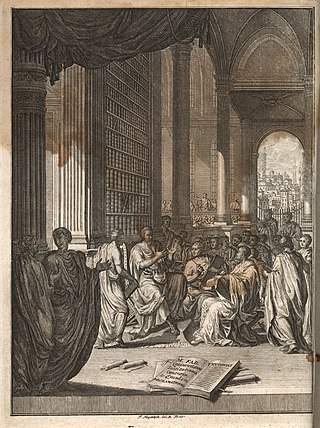
Public speaking, also called oratory or oration, has traditionally been defined as speaking in person to a live audience. Today, the term can also refer to speaking to an audience through digital technology.

Rhetoric is the art of persuasion. It is one of the three ancient arts of discourse (trivium) along with grammar and logic/dialectic. As an academic discipline within the humanities, rhetoric aims to study the techniques that speakers or writers use to inform, persuade, and motivate their audiences. Rhetoric also provides heuristics for understanding, discovering, and developing arguments for particular situations.

A sign is an object, quality, event, or entity whose presence or occurrence indicates the probable presence or occurrence of something else. A natural sign bears a causal relation to its object—for instance, thunder is a sign of storm, or medical symptoms a sign of disease. A conventional sign signifies by agreement, as a full stop signifies the end of a sentence; similarly the words and expressions of a language, as well as bodily gestures, can be regarded as signs, expressing particular meanings. The physical objects most commonly referred to as signs generally inform or instruct using written text, symbols, pictures or a combination of these.

Marcus Fabius Quintilianus was a Roman educator and rhetorician born in Hispania, widely referred to in medieval schools of rhetoric and in Renaissance writing. In English translation, he is usually referred to as Quintilian, although the alternate spellings of Quintillian and Quinctilian are occasionally seen, the latter in older texts.

Rhetorical criticism analyzes the symbolic artifacts of discourse—the words, phrases, images, gestures, performances, texts, films, etc. that people use to communicate. Rhetorical analysis shows how the artifacts work, how well they work, and how the artifacts, as discourse, inform and instruct, entertain and arouse, and convince and persuade the audience; as such, discourse includes the possibility of morally improving the reader, the viewer, and the listener. Rhetorical criticism studies and analyzes the purpose of the words, sights, and sounds that are the symbolic artifacts used for communications among people.

Inventio, one of the five canons of rhetoric, is the method used for the discovery of arguments in Western rhetoric and comes from the Latin word, meaning "invention" or "discovery". Inventio is the central, indispensable canon of rhetoric, and traditionally means a systematic search for arguments.

Dispositio is the system used for the organization of arguments in the context of Western classical rhetoric. The word is Latin, and can be translated as "organization" or "arrangement".

Memoria was the term for aspects involving memory in Western classical rhetoric. The word is Latin, and can be translated as "memory".

Elocutio is a Latin term for the mastery of rhetorical devices and figures of speech in Western classical rhetoric. Elocutio or style is the third of the five canons of classical rhetoric that concern the craft and delivery of speeches and writing.

The term composition as it refers to writing, can describe authors' decisions about, processes for designing, and sometimes the final product of, a composed linguistic work. In original use, it tended to describe practices concerning the development of oratorical performances, and eventually essays, narratives, or genres of imaginative literature, but since the mid-20th century emergence of the field of composition studies, its use has broadened to apply to any composed work: print or digital, alphanumeric or multimodal. As such, the composition of linguistic works goes beyond the exclusivity of written and oral documents to visual and digital arenas.
Gilbert Austin (1753–1837) was an Irish educator, clergyman and author. Austin is best known for his 1806 book on chironomia, Chironomia, or a Treatise on Rhetorical Delivery. Heavily influenced by classical writers, Austin stressed the importance of voice and gesture to a successful oration.

Owing to its origin in ancient Greece and Rome, English rhetorical theory frequently employs Greek and Latin words as terms of art. This page explains commonly used rhetorical terms in alphabetical order. The brief definitions here are intended to serve as a quick reference rather than an in-depth discussion. For more information, click the terms.
The art of memory is any of a number of loosely associated mnemonic principles and techniques used to organize memory impressions, improve recall, and assist in the combination and 'invention' of ideas. An alternative term is "Ars Memorativa" which is also translated as "art of memory" although its more literal meaning is "Memorative Art". It is also referred to as mnemotechnics. It is an 'art' in the Aristotelian sense, which is to say a method or set of prescriptions that adds order and discipline to the pragmatic, natural activities of human beings. It has existed as a recognized group of principles and techniques since at least as early as the middle of the first millennium BCE, and was usually associated with training in rhetoric or logic, but variants of the art were employed in other contexts, particularly the religious and the magical.

Institutio Oratoria is a twelve-volume textbook on the theory and practice of rhetoric by Roman rhetorician Quintilian. It was published around year 95 AD. The work deals also with the foundational education and development of the orator himself.

A funeral oration or epitaphios logos is a formal speech delivered on the ceremonial occasion of a funeral. Funerary customs comprise the practices used by a culture to remember the dead, from the funeral itself, to various monuments, prayers, and rituals undertaken in their honour. In ancient Greece and, in particular, in ancient Athens, the funeral oration was deemed an indispensable component of the funeral ritual.

The Rhetoric to Alexander is a treatise traditionally attributed to Aristotle. It is now generally believed to be the work of Anaximenes of Lampsacus.
In prosody a paeon is a metrical foot used in both poetry and prose. It consists of four syllables, with one of the syllables being long and the other three short. Paeons were often used in the traditional Greek hymn to Apollo called paeans. Its use in English poetry is rare. Depending on the position of the long syllable, the four paeons are called a first, second, third, or fourth paeon.

A Dialogue Concerning Oratorical Partitions is a rhetorical treatise, written by Cicero. According to the method of the Middle Academy, the treatise is sometimes described as a "catechism of rhetoric," for it is presented in the form of questions and answers. Cicero wrote it as a handbook for his young son, Marcus, and structured the text as a dialogue between the two of them.

In classical rhetoric, figures of speech are classified as one of the four fundamental rhetorical operations or quadripartita ratio: addition (adiectio), omission (detractio), permutation (immutatio) and transposition (transmutatio).

Feminist rhetoric emphasizes the narratives of all demographics, including women and other marginalized groups, into the consideration or practice of rhetoric. Feminist rhetoric does not focus exclusively on the rhetoric of women or feminists, but instead prioritizes the feminist principles of inclusivity, community, and equality over the classic, patriarchal model of persuasion that ultimately separates people from their own experience. Seen as the act of producing or the study of feminist discourses, feminist rhetoric emphasizes and supports the lived experiences and histories of all human beings in all manner of experiences. It also redefines traditional delivery sites to include non-traditional locations such as demonstrations, letter writing, and digital processes, and alternative practices such as rhetorical listening and productive silence. According to author and rhetorical feminist Cheryl Glenn in her book Rhetorical Feminism and This Thing Called Hope (2018), "rhetorical feminism is a set of tactics that multiplies rhetorical opportunities in terms of who counts as a rhetor, who can inhabit an audience, and what those audiences can do." Rhetorical feminism is a strategy that counters traditional forms of rhetoric, favoring dialogue over monologue and seeking to redefine the way audiences view rhetorical appeals.






